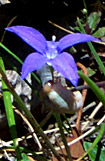|
[Front Page] [Features] [Departments] [SGAP Home Page] [Subscribe]

Australian Floral Emblems
Wahlenbergia gloriosa
The following article was compiled by officers of the National Botanic Gardens, Canberra to introduce Wahlenbergia gloriosa (the royal bluebell) to the general public as the floral emblem of the Australian Capital Territory. The announcement of the choice of floral emblem was made on 26 May 1982 by the Minister for the Capital Territory, Michael Hodgman.
At the Minister's request, a committee was formed in November 1981, consisting of Dr R.W.Boden (chairman), Mr M.Gray, Professor L.D.Pryor, Mrs L.Rudduck and Mr J.F.Wrigley, to advise him on a suitable emblem. The committee reviewed the flora native to the Australian Capital Territory (ACT) and unanimously recommended the royal bluebell.
The bell shape of the royal bluebell is readily adapted to stylised forms for use in promotions, and also as a motif for such things as blazer pockets of sporting teams.
 
Scientific name: The genus Wahlenbergia, which belongs to the family Campanulaceae, was named by the German botanist, H.A.Schrader, in 1814 in honour of Georg Goran Wahlenberg (1780 - 1851), professor of botany at Uppsala, Sweden, who was noted for his studies of European plant geography.
The species name, gloriosa, is Latin, meaning superb or glorious.
Botanical description: Perennial herb with several to many simple stems sometimes branching above the short leafy basal portion; leaves usually opposite, dark green, one to 2.5 centimetres long, widest at the top, margins conspicuously undulate, more or less hairy at the base. Flowers erect on long slender stems with a few distant narrow bracts, deep blue, about three centimetres in diameter, sepals five to seven millimetres long; petals usually five, joined in a tube four to six millimetres long with spreading lobes 12 to 18 millimetres long. Fruit a capsule, obconical 12 to 15 millimetres long, five to six millimetres in diameter, prominently ribbed and surmounted by the 5 erect sepals.
Distribution: The genus Wahlenbergia occurs in South Africa, South America, New Zealand and Australia. The species Wahlenbergia gloriosa is restricted to the high mountain forests and woodlands of the ACT, south-eastern New South Wales and eastern Victoria, above about 1,300 metres.
Culture: Wahlenbergia gloriosa has been known in cultivation for many years. It is a frost hardy ground cover flowering in Canberra from late October till February.
It does best in a light, enriched soil in either a sunny or semi-shaded situation. The soil can be enriched by use of a well rotted compost or other organic matter. As the plant is very shallow rooted, the soil should be kept moist but not water-logged. The organic material added to the soil also helps to lighten it, thus enabling the plant to sucker and spread, sometimes over large distances. Even though it suckers, it does not have the potential to become a problem in the garden. Feeding with a liquid fertiliser during the growing seasons of spring and autumn could produce more vigorous growth.
 |
The vivid blue flowers of the royal bluebell make this an easily identified plant in the natural areas around Canberra.
Photo: Nathan Hurst.
|
Propagation: This can be carried out by three methods:
Division, where small "plugs" of the plant are taken and either transplanted to other parts of the garden or into pots for growing on. This method can be used at almost any time of the year except the height of summer.
Cutting, where small lengths of roots or stems are removed from the plant and set as for normal cuttings. This can be done at any time of the year.
- Seed, collected from November till May can be sown in a punnet containing fine sand and kept moist until germination takes place. The seedlings are then pricked out into pots and grown on until ready for planting.
It should be remembered that the royal bluebell is protected in the wild and should not be picked or collected.
Reprinted from the September 1982 issue of the newsletter of the Canberra Region of SGAP. Diagram by Marjory May.

[Front Page] [Features] [Departments] [SGAP Home Page] [Subscribe]
Australian Plants online - December 1997
The Society for Growing Australian Plants
|